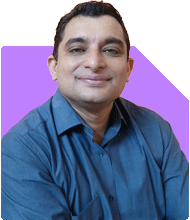42, 1.9L Take Home, How to Invest 75k/month?
Ramalingam Kalirajan |10902 Answers |Ask -Follow
Mutual Funds, Financial Planning Expert - Answered on Nov 04, 2024
He has an MBA in finance from the University of Madras and is a certified financial planner.
He is the director and chief financial planner at Holistic Investment, a Chennai-based firm that offers financial planning and wealth management advice.... more

I am 42, and my current take home is 1.9 lakh per month. I have a home loan for which I paying 50K EMI. Currently my only investment is 5k monthly SIP and monthly EPF for 22k with current balance of 13 lakh. Now after all expenses I am am able to save 70-75k monthly. Can you please share a road map where I should invest money with 30k amount as high liquidity and flexibility and 40 as long term investment and any other suggestions for investment
Key Focus Areas for Your Financial Growth
For a comprehensive strategy, it’s essential to look at both liquidity needs and long-term growth. Given your current savings capacity, we’ll divide your Rs. 70-75k monthly savings effectively.
Here’s how to structure your investments with a balanced approach:
1. Allocating Rs. 30,000 for High Liquidity and Flexibility
In this portion, we’ll target investments that offer quick access to funds while providing a safety net for emergencies and short-term goals.
Liquid Funds
Liquid funds are low-risk and give quick access to cash within a day or two. These funds invest in short-term securities, providing stable returns with high liquidity. This option helps you build an emergency reserve without sacrificing flexibility.
Ultra-Short-Term Funds
Ultra-short-term funds offer slightly better returns than liquid funds but still maintain liquidity. They suit short-term goals and unexpected expenses. Ultra-short-term funds usually require a holding period of three months for optimal returns.
Recurring Deposits (RD)
If you prefer traditional investments, consider an RD with a 6-12 month term. It’s ideal for conservative investors seeking stable growth in liquid funds. It adds a disciplined approach to your savings without tying up funds long-term.
Money Market Funds
Money market funds provide a stable place for parking cash with moderate returns. They invest in high-quality, short-term debt instruments, offering security and fast access to funds. You can liquidate these investments quickly if needed.
2. Allocating Rs. 40,000 for Long-Term Wealth Creation
Long-term investments form the backbone of your financial growth. We’ll focus on higher-growth instruments for wealth building.
Equity Mutual Funds for High Returns
Equity mutual funds are ideal for a 5-10 year horizon and have high growth potential. With actively managed funds, your investment is continuously optimised by fund managers to outperform the market. Unlike index funds, actively managed funds allow for strategic shifts based on market conditions.
Balanced Advantage Funds for Stability and Growth
These funds blend equity and debt, balancing risk while delivering steady returns. They dynamically adjust between debt and equity, helping reduce volatility. They’re a safe choice if you want exposure to equity with controlled risk.
Public Provident Fund (PPF)
PPF is a government-backed option with tax-free returns and long-term benefits. It’s an excellent choice for retirement planning and fits well into a tax-efficient portfolio. It provides a 15-year horizon, aligning with long-term goals.
Debt Funds for Low-Risk Growth
Debt funds are suitable for steady, low-risk income. They invest in corporate bonds and government securities, providing reliable returns. They’re tax-efficient for long-term investors, especially if your income tax slab is high.
Assessing Your Home Loan and EMI Payment Strategy
Paying Rs. 50,000 monthly towards EMI affects your cash flow. You may consider partial pre-payments when feasible to reduce the loan burden. This strategy can help reduce interest over time and ease cash flow, freeing funds for further investment.
Strengthening Your Emergency Fund
An emergency fund is essential to manage unexpected expenses without disrupting your investments.
Set aside six months’ expenses in a high-liquidity option.
Liquid funds or ultra-short-term funds are excellent choices for this buffer.
Aim to allocate a portion of your Rs. 30,000 liquidity funds toward building this reserve.
Enhance Long-Term Security with Retirement Planning
Your monthly EPF contribution of Rs. 22,000 is a strong start. However, considering your future expenses, bolstering your retirement fund will help you secure financial freedom.
National Pension System (NPS)
NPS provides tax-efficient growth for retirement. It invests in equity and debt based on your chosen risk profile, ensuring consistent growth for retirement. NPS offers benefits under Section 80C and 80CCD, giving you tax savings along with growth.
PPF Contributions
Consider supplementing EPF with PPF to balance your retirement fund. PPF provides assured returns, tax efficiency, and can serve as a reliable income source in retirement.
Avoid Direct Funds for Optimized Guidance and Security
Direct funds require continuous market knowledge and time to manage. Instead, consider investing through a Mutual Fund Distributor (MFD) with Certified Financial Planner (CFP) credentials. This guidance brings expertise and helps you make strategic choices in volatile markets, giving better returns without direct fund challenges.
Tax Implications for Your Investments
Your investments should also focus on tax efficiency to maximise post-tax returns.
Equity Mutual Fund Taxation
Long-term capital gains (LTCG) above Rs. 1.25 lakh are taxed at 12.5%. Short-term capital gains (STCG) are taxed at 20%. Equity investments should be held long-term to gain tax benefits.
Debt Fund Taxation
Debt funds are taxed as per your income slab, whether LTCG or STCG. They’re tax-efficient for those in high tax brackets and suit a stable, long-term portfolio.
Diversifying Your Investment Portfolio for Balanced Growth
To achieve a balanced portfolio, you’ll want diversity across asset classes, combining high growth with stability.
Gold Bonds
Gold bonds are government-backed, low-risk, and help hedge against inflation. They’re also tax-efficient and have no capital gains tax if held to maturity, making them ideal for a diversified portfolio.
Large-Cap and Mid-Cap Funds
Large-cap funds provide stability and lower risk, while mid-cap funds offer higher growth. Combining these funds aligns with your risk appetite and long-term growth goals.
Final Insights
A well-planned investment strategy can create financial stability and growth for your future. By focusing on a balanced approach, with Rs. 30,000 for liquidity and Rs. 40,000 for long-term investments, you secure flexibility and future wealth.
Stay consistent with these contributions, and make adjustments as needed. Working with a Certified Financial Planner can further refine this roadmap, helping you optimise each step of your investment journey.
Best Regards,
K. Ramalingam, MBA, CFP,
Chief Financial Planner,
www.holisticinvestment.in
https://www.youtube.com/@HolisticInvestment
You may like to see similar questions and answers below
Ramalingam Kalirajan |10902 Answers |Ask -Follow
Mutual Funds, Financial Planning Expert - Answered on May 13, 2024
Ramalingam Kalirajan |10902 Answers |Ask -Follow
Mutual Funds, Financial Planning Expert - Answered on Jul 19, 2024
Ramalingam Kalirajan |10902 Answers |Ask -Follow
Mutual Funds, Financial Planning Expert - Answered on May 15, 2025
Ramalingam Kalirajan |10902 Answers |Ask -Follow
Mutual Funds, Financial Planning Expert - Answered on Jul 07, 2025
Anu Krishna |1749 Answers |Ask -Follow
Relationships Expert, Mind Coach - Answered on Dec 17, 2025
Anu Krishna |1749 Answers |Ask -Follow
Relationships Expert, Mind Coach - Answered on Dec 17, 2025
Radheshyam Zanwar |6748 Answers |Ask -Follow
MHT-CET, IIT-JEE, NEET-UG Expert - Answered on Dec 17, 2025
Anu Krishna |1749 Answers |Ask -Follow
Relationships Expert, Mind Coach - Answered on Dec 17, 2025
Dr Shakeeb Ahmed Khan |184 Answers |Ask -Follow
Physiotherapist - Answered on Dec 17, 2025
T S Khurana |538 Answers |Ask -Follow
Tax Expert - Answered on Dec 17, 2025
T S Khurana |538 Answers |Ask -Follow
Tax Expert - Answered on Dec 17, 2025
Janak Patel |72 Answers |Ask -Follow
MF, PF Expert - Answered on Dec 17, 2025
Ramalingam Kalirajan |10902 Answers |Ask -Follow
Mutual Funds, Financial Planning Expert - Answered on Dec 17, 2025
Samraat Jadhav |2511 Answers |Ask -Follow
Stock Market Expert - Answered on Dec 17, 2025


























